How To Hit A Curve Ball/
Opposite Field
I love it when I’m watching a Major League game and a batter comes to the plate and the announcer says, “This guy is a good fastball hitter”.Yeah, no kidding. Who in the Major Leagues isn’t? But how many times do they say, “This guy is a good breaking ball hitter”.
As a former Minor League player. I saw guys that could destroy a fastball. But they couldn’t hit the curve ball, probably kept them from getting to the Big Leagues. Or at least staying there.
I still play baseball in the “Men’s Senior Baseball League” and at this age a lot of guys throw curve balls just because they don’t have much of a fastball anymore.
I see it over and over again from guys on my team and from opposing teams. Can’t hit the curve ball.
Another thing that drives me crazy is when a hitter who struggles with a curve ball, takes the first pitch fastball for a stirike, just because it’s the first pitch. Pitcher’s want to get ahead in the count. Their best pitch is strike one. So why take it?
Most pitchers have more control over their fastball than their curve ball. Plus, most hitters can handle the fastball better. So I would think you would look fastball on the first pitch. Then, if it’s a curve ball you might take it.
When it comes to hitting the curve ball there are two things you need to do. First, PAY ATTENTION. Second, your hitting mechanics must be correct.
Pay Attention:
Before the game when the opposing pitcher is warming up, when your team-mates are hitting, when you’re on deck. Pay attention.
Watch to see if the pitcher is getting his curve ball over, if he’s throwing it for a strike or is it always breaking out of the strike zone? Does he have enough confidence to throw it when he’s behind in the count. Does he throw it on the first pitch? Does he break it inside or outside?
Also watch his delivery. Does he change his arm angle when he throws the curve ball? (Different release point). Some pitchers will subconsciously slow down their arm. Does he fumble in his glove to get the curve ball grip?
All these things can give you an advantage when trying to hit a curve ball.
Ted Williams called “Intelligent Anticipation”.
It’s not guessing. It’s just logic.
My theory is to swing early in the count. Especially on fastballs. This way if you have trouble with the curve, you might not be in there long enough to see one.
When I was a young player, I too had a hard time hitting a curve ball. I was fourteen years old. My coach, Larry Bisbing, was throwing batting practice. He threw me curve after curve and all I was doing was rolling them to the short stop.
Finally he said to me, “ Please, please, hit that ball to right field.” (I'm a right hand hitter).
Then he explained about staying inside the baseball. I had never heard that term before. But I practiced it religiously and soon I was smashing curveballs to the opposite field.
In fact, when I signed with the Philadelphia Phillies organization, the scout told me that one thing he liked was that I didn’t have trouble hitting a curve ball.
To hit a curve ball your swing mechanics must be sound. In fact, to consistently hit anything they must be sound. But particularly the curve ball. Not only is it curving, but it is slower. You might have a tendency to “get out in front”.
My advice is to hit the ball to the opposite field if the pitch is middle or middle/away. An inside curve ball can be pulled, as long as you stay “inside the ball”.
So, how do you Hit the ball to the opposite field?
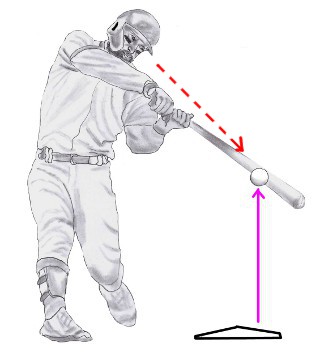
This is my drawing of Bryce Harper. Harper hit this curve ball from a lefty into the left center field seats. Look where the pitch is at contact in relation to home plate. It’s on the outside part. Also, it’s belt high. When a curve ball starts at your knees, it will finish out of the strike zone.
Also, look where his eyes are.
If Harper had tried to pull this pitch, he most likely would have grounded out to the right side.
Let’s look at his swing mechanics.
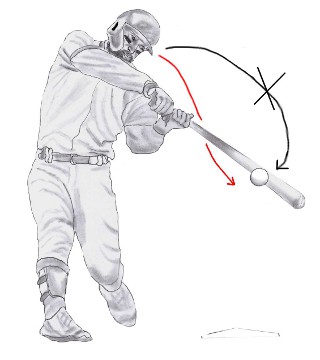
As Harper swings at this curve ball from a left handed pitcher, he is inside the ball. What I mean by that is, as he brings the bat around, his hands stay between his body and the ball. He’s “connected”. He is swinging from the inside out.(Red Arrow). This is the way you hit any pitch, but for sure, a curve ball.
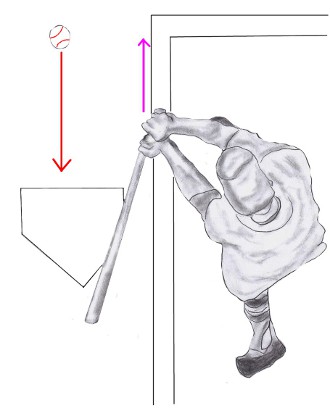
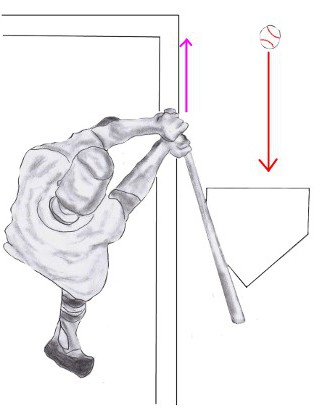
His hands are inside the flight of the baseball. This allows him to hit the outside pitch as well as the inside pitch. If he casted his hands out, around the ball, it would have been a different result.(Black Arrow Above).
If Harper would have “casted” his bat, meaning getting out and around the ball, (his hands and rear elbow out away from his body) his bat path would be cutting across the strike zone from outside to inside. Resulting in a pulled ground ball. (Black Arrow).
So, how do you “stay inside the ball?
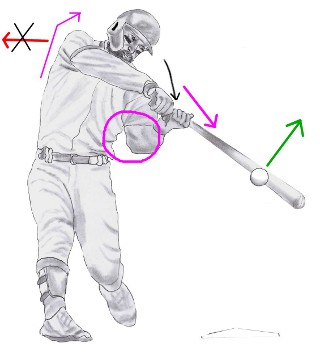
Harper is NOT opening, or rotating horizontally, toward the dugout. He is pulling his front shoulder up and back toward the backstop. He's tilted. His front shoulder is obviously higher than his back shoulder. This keeps his hands inside the ball.
His rear elbow falls into the slot close to his rear hip. Most times, against his hip (Blue circle). And his arms are still bent at contact. Extension doesn’t happen until after contact.
His front foot is still closed. When his front foot hit the ground, his toes were pointing toward the plate. This keeps his hips closed until you really need them. His foot opened toward the pitcher a little as he rotated, but it’s still not pointing at the pitcher.
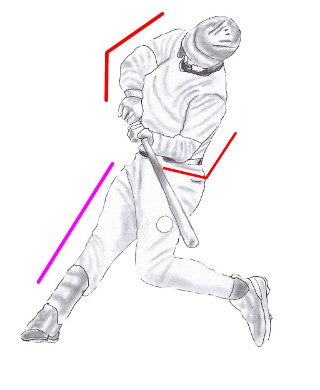
Here’s the side view of the same swing. You can clearly see the bent arms in close to his body at contact. This enables him to stay inside the pitch and gives him more strength.
If you were going to pick up a 50 pound bag of cement, or climb a rope, would you keep your arms in close to your body, or have your arms out away from your body? Obviously in close because that’s where your strength is.
This pulling action up and back with your front shoulder allows you to do this.
At contact, your head should be between your feet. If you let your head drift father front, over your front foot, you are too far front. You will lose power, your top hand will “roll over” too soon and probably will hit a ground ball to your pull side. This will allow you to let the ball travel so you can hit it deeper in the strike zone.
He did not try to hit this pitch out in front of him. It’s directly over the plate.
Another thing about this up and back shoulder direction. Besides allowing you to stay inside the ball, it gives you a rubber band like, buggy whip snap into your swing.
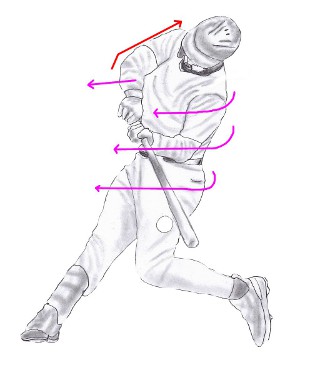
The blue arrows represent the direction Harper’s hands, arms and hips are going. The red arrow shows the direction his front shoulder is going. His muscles are actually going in opposite directions. This creates torque and stretch.The same action as pulling back on a rubber band.
I've used this example before but it applies here. Try this test.
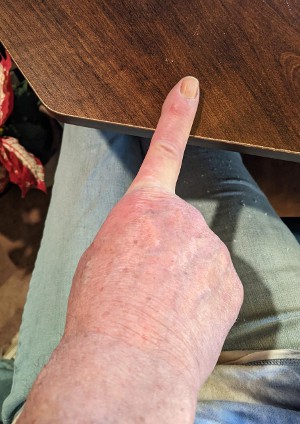
Extend the index finger on your right hand. Now tap your finger against a table top as hard as you can.
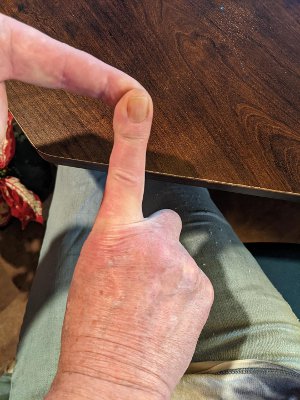
Now, do it again, but this time pull back on your finger with your left finger while your right hand moves forward. Let it snap against the table. Much more “snap” and force now.
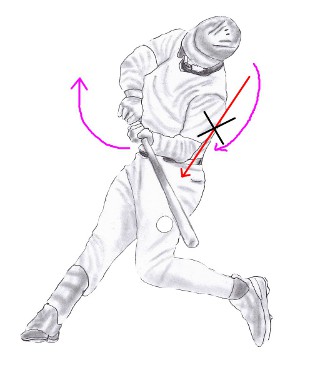
Harper is NOT driving the knob of his bat to the ball. As his bat comes around he is turning the knob up. His hands are clearly above the bat head and inside the pitch.
If you incorporate all these things into your swing, you will hit a lot of pitches to your opposite field without even trying. It will become your natural swing.
Remember how great hitters of the past mostly hit to all fields? This is how they did it. By keeping your hands inside the flight of the ball, and swinging slightly up, your bat will be in the plane of the ball longer. This will make it much easier to hit the ball deeper in the strike zone. You will also be less likely to get fooled on an off speed pitch.
If you have never heard of all this, it might sound confusing. It’s really not, but to make all this a part of your swing, it will take many, many swings to make it a permanent part of your mechanics.
I use a weighted bat while practicing my swing. A weighted “donut” will do.
Check List:
Practice your swing, incorporating all these actions. Swing in slow motion at first. Work on one thing at a time. Repetition creates muscle memory. After a while you will do these things without thinking about them.
It’s a good idea to swing in front of a full length mirror or at least somewhere that you can see your shadow in front of you.
When I practice my swing, I stand in front of a tarp I hung up. I position my self just far enough away from it that if my weight gets too far out front, my bat will hit the tarp. I wouldn’t do this with a mirror though.
1. Your front shoulder does NOT rotate horizontally as you swing. Make sure it’s moving up and back.
2. Do NOT drive the knob to the ball. Your bat comes around your rear shoulder. The swing is slightly upward.
3. Your rear elbow stays close to or against your rear hip as you swing. This is “connected”. Hands stay between your body and the flight of the ball.
4. Visualize making contact deeper in the strike zone. Arms are bent at contact. Extension happens after contact.
5. Your head should be between your feet at contact. No farther.
6. Weight is against your front leg, not on top of it. Front foot toes pointing toward the plate.
All Rights Reserved.